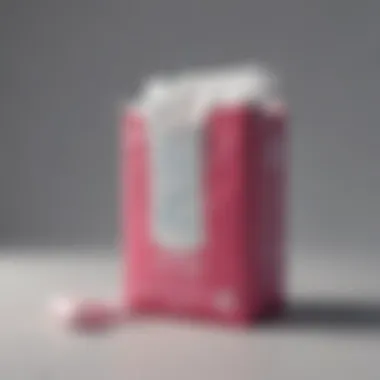Mastering Tampon Removal: A Complete Guide


Intro
Understanding the ins and outs of menstrual hygiene can feel like navigating a maze for some, especially when it comes to tampon removal. Many individuals have queries—some rooted in cultural beliefs, others in mere logistics—about how to properly remove a tampon. In this guide, we aim to cut through the confusion and deliver straightforward, practical advice. Whether you're a seasoned user or new to the world of tampons, our aim is to instill confidence and knowledge in those essential moments.
It's critical to recognize that menstrual health is more than just a phase; it's a vital aspect of one's overall well-being. From the moment you decide to use a tampon to the point of removal, each step has implications for hygiene, comfort, and ultimately, your health. We'll dig deep into techniques, potential pitfalls, and questions that often linger in the minds of users, breaking down the taboo surrounding this natural process.
By the end of this guide, you should feel equipped to approach tampon removal with ease, understanding, and perhaps even a bit of newfound confidence. Let's lay the groundwork to ensure you're ready for what comes next; after all, knowledge is the best tool in our kit when it comes to regulating one's menstrual experience.
Understanding Tampons
In diving into the world of feminine hygiene, one must appreciate the role that tampons play in managing menstrual health. Grasping the fundamentals of tampons not only enhances comfort but also informs best practices for use and removal, making it a vital topic in any comprehensive guide. Recognizing how tampons work and the different types available allows individuals to make educated choices suited to their personal needs and preferences. This understanding can alleviate potential concerns, ensuring that users feel empowered rather than overwhelmed by options and responsibilities.
What Is a Tampon?
A tampon is a small cylindrical absorbent product designed to be inserted into the vagina to absorb menstrual fluid. Made usually from cotton or a blend of materials, a tampon expands once moistened, effectively collecting blood and providing a discreet method of managing one's period. Unlike pads, which sit externally, tampons offer a different comfort level since they sit inside the body. Though they're easy to use, the right knowledge about their function is crucial. A well-informed user can enjoy the freedom and mobility that tampons offer without undue stress.
How Do Tampons Work?
The way a tampon functions is fairly straightforward yet ingenious. When inserted properly, the tampon's absorbent material draws in menstrual flow, preventing leaks. It's designed to fit snugly, so it manages fluid without causing discomfort. The string attached helps with removal, ensuring you can easily dispose of it once saturated. It's an effective system, yet it's particularly important to note the necessity of changing the tampon regularly to prevent any health risks, such as Toxic Shock Syndrome (TSS). Understanding this process lays down foundational knowledge that enhances overall menstrual health.
Types of Tampons
Tampons come in various types, each tailored to meet different needs and preferences. Let's examine three primary categories:
Regular
Regular tampons are designed for lighter days of the menstrual cycle. Their key characteristic is their absorbent capacity, which generally suits those who experience a moderate flow. Because of their versatility, regular tampons remain a popular choice for many women. The unique feature here is their comfort; they are neither too small nor too large, typically providing a sense of ease during wear.
Advantages:
- Comfortable for light to moderate flow.
- Easily available in most stores.
- Convenient for daily wear, comfortably manageable.
Super
Super tampons cater to medium to heavy flows, offering enhanced absorbency compared to regular ones. These tampons have a unique capability to manage larger volumes, making them beneficial on heavier days. Their primary appeal lies in their efficiency; users can wear them longer without the need to change as frequently.
Advantages:
- Excellent for heavier menstrual days.
- Reduces the frequency of changes needed.
- Made of breathable materials to enhance comfort.
Organic
Organic tampons are made from 100% cotton, free of synthetic dyes and additives, appealing to those concerned about chemicals in feminine hygiene products. In addition to their environmentally friendly nature, many seek them out for their soft texture and hypoallergenic properties. This type of tampon speaks directly to consumer demands for natural products, which is increasingly on the rise among health-conscious individuals.
Advantages:
- Safer for sensitive skin.
- Better for the environment.
- Contributes to reducing chemical exposure.
Understanding the varieties of tampons can provide insight into what might work best for your needs, preferences, and lifestyle. Whether leaning towards regular, super, or organic options, having a clear knowledge about the types available is the first step toward informed menstrual health management.
Preparation for Removal
Preparation for the removal of a tampon is an essential step in ensuring a smooth and comfortable experience. Proper preparation not only helps to promote hygiene but also minimizes any potential discomfort during the removal process. Understanding how to prep effectively can significantly enhance one’s overall menstrual experience.
Timing Your Removal
When to Remove
Knowing when to remove a tampon is crucial for maintaining comfort and health. Typically, tampons should be changed every 4 to 8 hours, depending on the flow. Leaving a tampon in for longer than recommended can increase the risk of Toxic Shock Syndrome, a rare but serious condition. This timeframe helps manage absorbency effectively and ensures that your body remains safe from potential infections.
One of the distinct advantages of being aware of when to remove a tampon is it grants women a sense of control over their menstrual health. Paying close attention to your body’s signals can make the experience more comfortable. However, over-reliance on the clock without recognizing physical signs can lead to leakage or discomfort, underscoring the importance of balance in managing tampon use.


Signs It's Time to Change
It's equally critical to recognize signs indicating that it is time to replace the tampon. Indicators such as discomfort from fullness, an increased sensation of wetness, or a hint of odor can signify that the tampon needs changing.
The benefit of being attuned to these signs is that it helps prevent the risk of odor and irritation. Uncomfortable situations can arise when a tampon is left in too long, making this awareness a practical tool in fostering a healthier menstrual cycle. Women who are in tune with their bodies typically find that they are better equipped to handle these signs effectively, leading to a more favorable menstrual experience.
Gathering Necessary Items
Clean Hands
Before getting into the removal process, having clean hands is non-negotiable. Washing your hands properly helps prevent introducing any harmful bacteria into the vaginal area. Not only does this practice enhance personal hygiene, but it also underpins the overall health management associated with tampon use.
A key characteristic of clean hands is that they provide peace of mind—knowing that your hands are free of germs allows for a more relaxed removal experience. Thus, taking a moment to wash hands with soap and water can save one from unnecessary worries. Neglecting this step can lead to infections, making it a crucial element of preparation.
Alternative Absorbents
In addition to preparation with clean hands, being aware of alternative absorbents is also beneficial. These options, such as pads, menstrual cups, or period underwear, can cater to varying flow levels and personal comfort preferences. Some individuals may prefer this route either for its ease of use or because of issues maintaining a regular tampon schedule.
The interesting part about alternative absorbents is that they provide options for environments where removing a tampon might be less convenient. Moreover, these options can reduce discomfort for those with heightened sensitivity. Each type offers unique features and benefits that can align well with varying lifestyles and personal choices.
Step-by-Step Tampon Removal
Removing a tampon correctly is fundamental to maintaining menstrual health and hygiene. Understanding how to approach tampon removal can greatly enhance the experience, making it not only safe but also comfortable. With the right techniques, you minimize the risk of discomfort, leakage, or any complications. This section details the steps to follow, emphasizing the importance of position and technique.
Finding a Comfortable Position
Standing
Standing, for many, is the most natural way to go about removing a tampon. This position offers a direct line of sight and control over the removal process. One key characteristic of standing is mobility; it allows you to adjust as necessary and feel a sense of balance.
A unique feature of standing is how it can help you feel more in control of your body, which is fundamental during the menstrual cycle when fluctuations in energy and mood can occur. However, some may find it less comfortable, especially if they experience cramps, and may prefer to try other positions first.
Sitting
Choosing to sit down is often preferred for those who feel more relaxed in this stance. Sitting offers a solid base and support, which can ease any anxiety around the process. It’s a familiar position, likely mirroring relaxation practices in other areas of life.
One of the advantages of sitting is that it can help alleviate any intense feelings you might have about the process. However, the unique aspect of this position is that if you have a heavy flow, there might be a risk of messing with the tampon's positioning resulting in a potential need for a quick change before removal.
Squatting
Squatting aligns the body in a way that opens the pelvic area, providing a different angle for removal. This position can be quite beneficial as it uses gravity to assist in the successful removal of the tampon. The key characteristic of squatting is increased access.
The unique feature here is the ability to leverage your muscles effectively. Though some might struggle with balance when squatting, many find it brings a sense of empowerment, and it can be ideal when one needs to ensure care in the removal process.
Gently Pulling the String
When it comes time to remove the tampon, gently pulling the string is critical. This step may seem straightforward, yet it requires mindfulness. Tension can add discomfort, so a soft tug while being aware of your body's response is the name of the game. If it feels stuck, remain calm—this can be a signal to reassess your angle or breathing.
Discarding the Tampon
Proper Disposal Methods
Understanding proper disposal methods makes a significant contribution to menstrual health practices and community standards. The key aspect here is to prioritize hygiene while also respecting the environment. Wrapping the tampon in toilet paper before tossing it in the trash is a beneficial option to avoid odors and maintain cleanliness.
The unique feature of proper disposal methods is that they reflect individual responsibility in managing menstrual products. It’s essential for maintaining one’s hygiene and also ensures that waste does not cause issues in plumbing systems.
Environmental Considerations
The environmental impact of menstrual products is worth noting. Many individuals are becoming more aware of how their choices affect the planet. The key characteristic of this consideration is sustainability. Switching to biodegradable options or those with less packaging not only supports personal health but the earth’s well-being too.
By considering environmental aspects, you also reduce the burden on waste systems, which is increasingly important as awareness about plastic pollution grows. Thus, integrating eco-friendly solutions into your menstrual routine is becoming a more recognized practice in contemporary society.
Post-Removal Care


When it comes to managing your menstrual health, what you do after tampon removal is just as important as the removal itself. Post-removal care encompasses a range of practices designed to promote hygiene and ensure your comfort. It’s about being mindful of your body and catching any potential issues early on.
Hygiene Practices
Washing Hands
A fundamental aspect of post-removal care is washing your hands thoroughly. It may sound simple, yet its importance cannot be overstated. After all, your hands are the primary means of interacting with personal care products, and maintaining cleanliness here prevents the risk of bacteria entering the body. It’s crucial to use warm water and soap, scrubbing for at least 20 seconds. This process reduces germs significantly, making it a beneficial practice.
One thing that stands out about washing hands after tampon use is how it creates a routine. This habit reinforces a sense of control over your menstrual hygiene. By ensuring your hands are clean, it minimizes the chances of infections such as bacterial vaginosis or yeast infections.
Skin Care
Another key area to address is skin care. This doesn’t just pertain to moisturizing after washing, but also involves being attentive to your vulva area. After tampoon removal, the skin can be sensitive, especially if you've been using tampons for several days. Applying a gentle, fragrance-free moisturizer can help soothe any irritation or dryness.
It’s worth noting that skin care can significantly impact your comfort during your menstrual cycle. Healthy skin prevents discomfort and irritation, creating a more pleasant experience throughout your menstruation period. This makes it a beneficial focus in the realm of post-removal care, ensuring your skin remains happy and healthy.
Recognizing Unusual Symptoms
Odor Changes
Changes in odor can be a red flag and signify other underlying issues. After removal, pay attention to any strong or foul odors. It's normal for menstrual blood to have a distinct smell, but an unexpected change may indicate an issue such as an infection. Recognizing this can provide you an early warning, allowing you to make proactive decisions about your health. It’s often said that one’s body is the best communicator—being aware of these changes is crucial.
Monitoring odor fluctuations can also empower you in your health journey. It’s about becoming attuned to your body’s signals and maintaining open lines of communication with your healthcare provider when needed.
Discoloration
Discoloration is another aspect to keep an eye on. This can include unusual changes in the menstrual flow, such as a shift from bright red to brown or black, each indicating different things. Recognizing these color changes is vital because it can point to hormonal imbalances or other issues ranging from normal variations to something requiring attention.
Healthy menstruation usually involves a variety of colors—this natural palette can change throughout the cycle. Being mindful of this spectrum helps you remain connected to your menstrual health. By paying attention, you can make informed decisions and seek medical advice when necessary.
Remember: Knowledge is power, and understanding your body is key to maintaining health and comfort during your menstrual cycle. Whether it’s washing your hands or recognizing unusual symptoms, these small steps make a big difference in your overall well-being.
Common Questions and Concerns
When it comes to using tampons, many people have questions that often reflect their anxieties and worries. This part of the article addresses those common queries, providing insights that are not only informative but also calming. Understanding these issues doesn't just help in easing concerns but also fosters a better grasp of menstrual health overall. Awareness about tampon use is essential; it can enhance one's confidence and contribute to a more comfortable experience during menstruation.
What If It Gets Stuck?
When using a tampon, the idea of it getting stuck can create panic. However, it's crucial to understand that this situation is not as alarming as it may sound. Staying calm is key.
Steps to Take
If you find that the tampon feels lodged, there are practical steps to follow. First, ensure you’re in a relaxed position. Often, tension can further complicate the situation. Gently push down while bearing down as if having a bowel movement, as this can help release the tampon from where it may be caught. If it isn't budging, you can try adjusting your position to see if it moves but be gentle. Always remember, excessive tugging can lead to discomfort. The most significant aspect here is patience; most tampons come out easily when not stressed.
Additionally, don't hesitate to seek help if needed. Speaking to a medical professional or a trusted friend can provide guidance and relief. The unique feature of these steps highlights their simplicity and effectiveness, turning a potentially stressful experience into a manageable one.
When to Seek Help
Occasionally, circumstances may arise where the tampon genuinely cannot be removed after following the initial steps. In such cases, knowing when to reach out for help is vital. If extreme discomfort, fever, or unusual discharge occurs, these are signs that professional medical assistance is necessary. Urgency is another important factor if you notice symptoms resembling Toxic Shock Syndrome, which can be serious.
The critical characteristic of understanding when to seek help lies in creating a sense of awareness about one’s body. This proactive approach empowers individuals to take charge of their health. The unique aspect of this discussion is that it helps strip down the stigma around menstruation, making it clear that seeking help is always okay.
Understanding Toxic Shock Syndrome
Toxic Shock Syndrome, or TSS, is another concern that often looms when discussing tampon use. This rare but potentially serious condition can arise from prolonged tampon use, so it’s crucial to remain informed.
Symptoms to Watch For
Awareness of the symptoms related to TSS is essential for early detection. Symptoms can include sudden high fever, rash, low blood pressure, and even confusion. Recognizing these symptoms can significantly contribute to the overall goal of promoting menstrual health.
The key characteristic of being vigilant about these symptoms allows you to respond quickly if something feels off. This innate quality of awareness can often be one's best defense. It encourages users to listen to their bodies, which can often tell you more than any guide.
Prevention Tips


Preventing TSS revolves around several key practices: change your tampon every four to eight hours, opt for the lowest absorbency necessary, and consider switching to other menstrual products like pads or menstrual cups periodically.
The significance of these tips is that they place control in your hands. They remind individuals that the choices they make around their menstruation can influence their overall well-being. The unique feature here lies in the balance of comfort and safety, making it easier for users to integrate these suggestions into their lives thoughtfully.
"Taking charge of your menstrual health isn't just about choice; it’s about empowerment and knowledge."
By covering these questions and concerns, this article aims to equip you with insight and clarity. This way, you can manage your menstrual health with confidence and ease.
Alternative Menstrual Products
When it comes to managing menstrual flow, not everyone finds tampons to be the best fit for their needs. This section focuses on some popular alternatives, each with its own set of advantages and considerations. Understanding these options is crucial, as it empowers individuals to choose methods that align best with their lifestyles, comfort levels, and values.
Pads
Pads have been a staple for many individuals during their menstruation. Simply put, they are absorbent materials that stick to the underwear, capturing menstrual flow reliably. For those who prefer not to insert anything into their bodies, pads offer an easy and straightforward alternative. They come in various thicknesses and absorbencies, making it possible to choose a pad that fits the wearer’s flow, whether light or heavy.
Benefits of Pads:
- Ease of Use: Simply peel and stick, ready to go.
- No Insertion Required: This makes pads a convenient option, especially for beginners or those who might be uncomfortable with internal products.
- Variety: They come in different shapes and sizes, including overnight options for added security.
- Discreetness: Modern designs are thinner and more comfortable, reducing bulkiness while wearing them.
However, there are some considerations to keep in mind:
- Discomfort in Hot Weather: Some people find pads less comfortable in hotter climates, as they can feel bulky or trap heat.
- Potentially Irritating: For some, prolonged contact can cause irritation or rashes. It is important to pay attention to skin reactions.
Menstrual Cups
Menstrual cups are gaining popularity due to their environmental benefits and versatility. These silicone or rubber cups are inserted into the vagina to collect menstrual fluid, allowing for longer wear without the need for frequent changes. This makes them not only cost-effective but also a sustainable choice, as they can last for several years with proper care.
Benefits of Menstrual Cups:
- Cost-Effective: A one-time purchase can serve for years, unlike disposable products.
- Eco-Friendly: Contributes to less waste, an important consideration for those mindful of the environment.
- Long Wear Time: Unlike tampons or pads, these can be worn for up to 12 hours, making them great for overnight use or long days.
On the flip side, there are some challenges:
- Learning Curve: The technique for insertion and removal can take a little practice, which may discourage some from trying.
- Hygiene Concerns: Users must be diligent about cleaning the cup regularly to prevent infections.
Period Underwear
Period underwear is a newer invention in menstrual products, gaining traction among those seeking comfort and sustainability. These are specially designed panties that offer absorbent protection without the need for additional products. Period underwear can absorb a similar amount of fluid as one to two tampons, depending on the brand and style.
Benefits of Period Underwear:
- Comfort: Designed for everyday wear, making them feel like regular underwear.
- Convenience: Just put them on and go about your day without worry.
- Less Waste: As they’re reusable, they reduce the need for disposable products.
However, there are also a few drawbacks:
- Cost: They can be more expensive upfront compared to traditional options, though they save money in the long run.
- Best for Light to Moderate Flow: Some brands may not be effective for heavy days, necessitating a backup product.
In the end, exploring various alternatives allows individuals to find what works best for them, enhancing comfort and confidence throughout their menstrual periods.
The End
Navigating the world of menstrual products can feel daunting at times, but this guide has shed light on the intricacies of tampon removal and the practices that accompany it. Understanding how to effectively, and safely, manage one’s menstrual health is of utmost importance. The act of removing a tampon, while seemingly mundane, comes with numerous nuances that can influence one's overall experience.
Knowledge is power, as they say. Here’s why empowering oneself through information is crucial. Recognizing the right timing for removal, the signs that indicate a change is needed, and what to do if something goes awry, are all invaluable parts of managing menstrual health. Additionally, being aware of different menstrual products and alternatives provides options that might suit individual preferences better.
Empowerment Through Knowledge
This final section emphasizes the idea that being informed leads to a more positive and confident experience during menstruation. Information about hygiene practices doesn’t just promote comfort; it also plays a pivotal role in preventing potential health issues.
When you know what to look for—unusual odors, discoloration, or feeling discomfort—you become attuned to your body’s communication. This awareness can mitigate anxiety around menstruation and help debunk myths. There’s no need to feel lost with guidelines and facts at your fingertips.
"Education is the most powerful weapon which you can use to change the world."
— Nelson Mandela
List of elements to consider:
- Health Awareness: Knowing what constitutes normal menstrual health can prevent complications.
- Comfortability: Understanding how to remove the tampon properly aids in ensuring a more comfortable experience.
- Exploration of Alternatives: Consideration of various menstrual products—like pads, menstrual cups, and period underwear—can lead to a discovery of what works best for you.
In wrapping this up, it’s beneficial to remember that each individual’s experience is unique. Engaging with these insights not only enhances personal hygiene but also fosters an overall positive approach to menstrual health and wellbeing.



